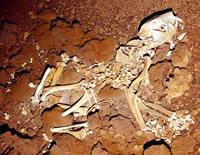 Researchers found the first-known complete skeleton of the marsupial 'lion' Thylacoleo carnifex in a cave under the Nullarbor Plain, Australia.Click here to see more images of this amazing animal.
Researchers found the first-known complete skeleton of the marsupial 'lion' Thylacoleo carnifex in a cave under the Nullarbor Plain, Australia.Click here to see more images of this amazing animal.The skeletons of eight new species of extinct kangaroo have been found amongst a bounty of fossils beneath the arid Nullarbor plain in south-central Australia.
In three caves, researchers unearthed the remains of 69 vertebrate species, plus a mollusc, that lived between 800,000 and 200,000 years ago1. The rare find sheds light on an intensely debated topic: what wiped out the large prehistoric animals, or megafauna, that roamed ancient Australia?
Palaeontologists say the newfound creatures lived in an arid climate similar to that of today. And that implies that climate change was not entirely responsible for wiping out the Australian megafauna, as some scientists have argued.
"For the first time we present evidence that there was a whole group of megafauna species adapted to relatively dry conditions," says Gavin Prideaux, a palaeontologist at the Western Australian Museum in Perth. "People that want to put the climate-change debate forward will now need to revise their hypothesis."
Wipe out
For millions of years, the sunburnt Australian landscape was populated by immense creatures such as wombat-like, rhinoceros-sized marsupials, 7-metre-long lizards, and carnivorous lions that lived in trees. Then, around 45,000 years ago — about the same time as humans arrived — Australia's great animals began to die out. The continent lost 90% of its megafauna within a few thousand years.
Exactly why remains a mystery. Some experts argue that as Australia experienced its last ice age, the animals could not adapt to colder and drier conditions (see 'Did climate shift kill giant Australian animals?'). Other scientists point the finger at our ancestors, claiming that early settlers destroyed both the creatures and their habitats in a 'blitzkrieg' of hunting and burning (see 'Fire-starters blamed for Australian extinctions').
In the new work, Prideaux's team dated the fossils by studying radioactive elements preserved in calcite crusts coating the bones. Next, by comparing other elements in the fossils' teeth to those in modern-day relatives such as kangaroos and wombats, the researchers reconstructed the animals' eating and drinking habits. The results indicate that they were mostly plant-eaters who spent their days grazing in a dry, open land. "Maybe it was slightly wetter than it is now, but the megafauna were clearly adapted to this really dry climate," says Prideaux.
Not everyone agrees with the new study's conclusions. "By taking such a simplistic approach you threaten to strangle much more complex issues," says Judith Field, an archaeologist at the University of Sydney, Australia. She believes climate change was responsible for the prehistoric decline, and that the arrival of humans simply tipped an already fragile system to extinction.
Anthony Stuart, a palaeontologist at University College London who works on Eurasian extinctions, agrees. Animals that are stressed by climate change are more vulnerable to being bumped off by people, he says: "It's just not a case of either/or."
Visit our troveoffossilsfoun.html">newsblog to read and post comments about this story.
To listen to an interview with Gavin Prideaux, the lead researcher, tune into this week's Nature podcast .
-
References
- Prideaux G. J., et al. Nature, 445. 422 - 425 (2007). | Article |
